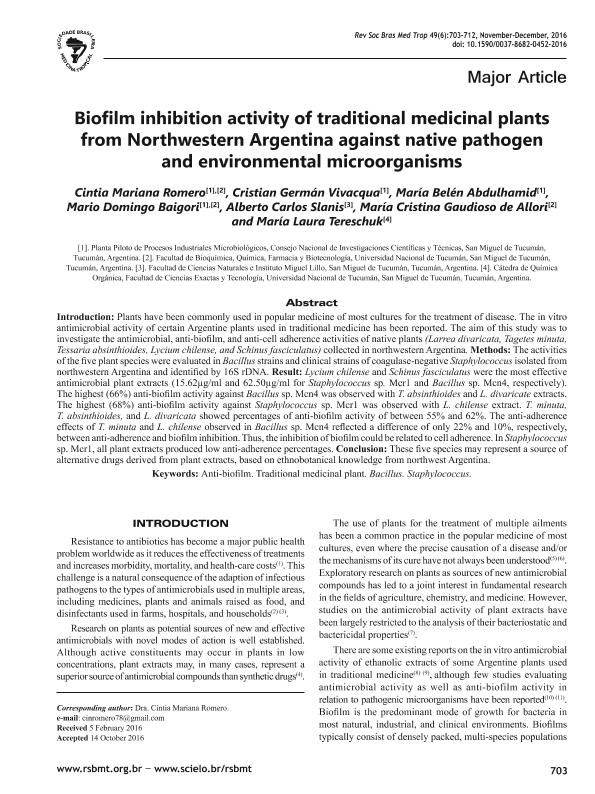Artículo
Biofilm inhibition activity of traditional medicinal plants from Northwestern Argentina against native pathogen and environmental microorganisms
Romero, Cintia Mariana ; Vivacqua, Cristian Germán; Abdulhamid, María Belén
; Vivacqua, Cristian Germán; Abdulhamid, María Belén ; Baigori, Mario Domingo
; Baigori, Mario Domingo ; Slanis, Carlos Alberto; Gaudioso de Allori, María Cristina; Tereschuk, María Laura
; Slanis, Carlos Alberto; Gaudioso de Allori, María Cristina; Tereschuk, María Laura
 ; Vivacqua, Cristian Germán; Abdulhamid, María Belén
; Vivacqua, Cristian Germán; Abdulhamid, María Belén ; Baigori, Mario Domingo
; Baigori, Mario Domingo ; Slanis, Carlos Alberto; Gaudioso de Allori, María Cristina; Tereschuk, María Laura
; Slanis, Carlos Alberto; Gaudioso de Allori, María Cristina; Tereschuk, María Laura
Fecha de publicación:
11/2016
Editorial:
Sociedade Brasileira de Medicina Tropical
Revista:
Revista da Sociedade Brasileira de Medicina Tropical
ISSN:
0037-8682
e-ISSN:
1678-9849
Idioma:
Inglés
Tipo de recurso:
Artículo publicado
Clasificación temática:
Resumen
Introduction: Plants have been commonly used in popular medicine of most cultures for the treatment of disease. The in vitro antimicrobial activity of certain Argentine plants used in traditional medicine has been reported. The aim of this study was to investigate the antimicrobial, anti-biofilm, and anti-cell adherence activities of native plants (Larrea divaricata, Tagetes minuta, Tessaria absinthioides, Lycium chilense, and Schinus fasciculatus) collected in northwestern Argentina. Methods: The activities of the five plant species were evaluated in Bacillus strains and clinical strains of coagulase-negative Staphylococcus isolated from northwestern Argentina and identified by 16S rDNA. Result: Lycium chilense and Schinus fasciculatus were the most effective antimicrobial plant extracts (15.62µg/ml and 62.50µg/ml for Staphylococcus sp. Mcr1 and Bacillus sp. Mcn4, respectively). The highest (66%) anti-biofilm activity against Bacillus sp. Mcn4 was observed with T. absinthioides and L. divaricate extracts. The highest (68%) anti-biofilm activity against Staphylococcus sp. Mcr1 was observed with L. chilense extract. T. minuta, T. absinthioides, and L. divaricata showed percentages of anti-biofilm activity of between 55% and 62%. The anti-adherence effects of T. minuta and L. chilense observed in Bacillus sp. Mcn4 reflected a difference of only 22% and 10%, respectively, between anti-adherence and biofilm inhibition. Thus, the inhibition of biofilm could be related to cell adherence. In Staphylococcus sp. Mcr1, all plant extracts produced low anti-adherence percentages. Conclusion: These five species may represent a source of alternative drugs derived from plant extracts, based on ethnobotanical knowledge from northwest Argentina.
Palabras clave:
Anti-Biofilm
,
Bacillus
,
Staphylococcus
,
Traditional Medicinal Plant
Archivos asociados
Licencia
Identificadores
Colecciones
Articulos(PROIMI)
Articulos de PLANTA PILOTO DE PROC.IND.MICROBIOLOGICOS (I)
Articulos de PLANTA PILOTO DE PROC.IND.MICROBIOLOGICOS (I)
Citación
Romero, Cintia Mariana; Vivacqua, Cristian Germán; Abdulhamid, María Belén; Baigori, Mario Domingo; Slanis, Carlos Alberto; et al.; Biofilm inhibition activity of traditional medicinal plants from Northwestern Argentina against native pathogen and environmental microorganisms; Sociedade Brasileira de Medicina Tropical; Revista da Sociedade Brasileira de Medicina Tropical; 49; 6; 11-2016; 703-712
Compartir
Altmétricas



